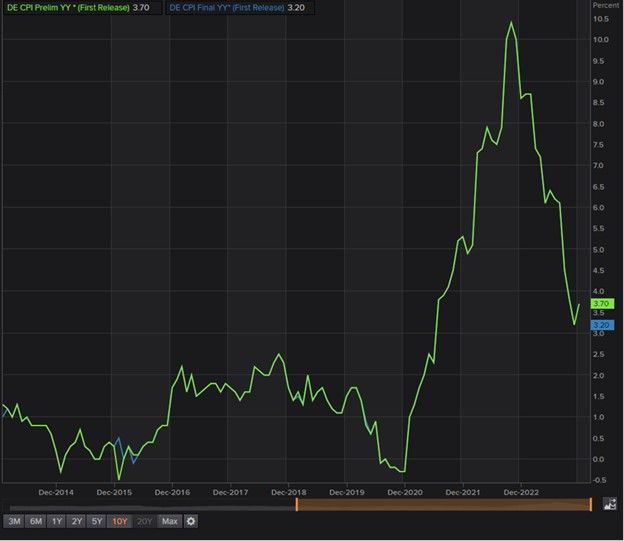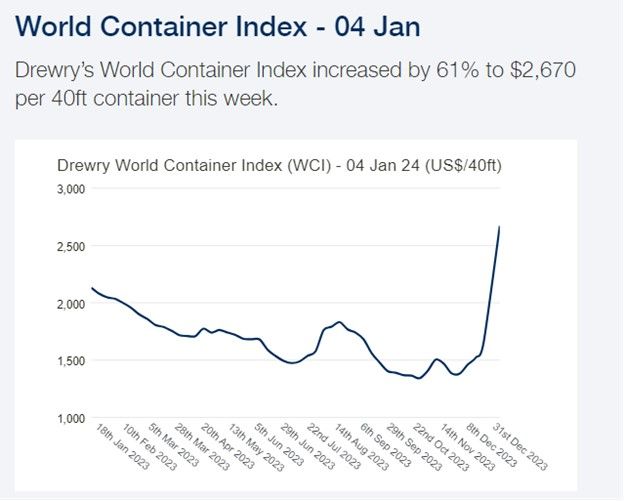Monday Jan 8 2024 11:08

5 min

Slackish start to trade for European equities on Monday with the major indices floating around in the brackish water around the flatline. The FTSE 100 dropped a third of a percent and drifted towards the bottom of the January channel with heavyweight Shell down 2%. The DAX traded a tad firmer, whilst the CAC in Paris was steady. US stocks broke a nine-week winning streak on Friday, though the S&P 500 closed marginally higher for the session. The Nasdaq composite fell more than 3% for the week as bond yields rose with investors reassessing the speed at which the Federal Reserve will begin cutting rates. Crude slipped as Saudi Arabia cut prices for Asian customers to a 27-month low. Dow futures are off south as Boeing plunges almost 9% in pre-mkt trading due to grounding of some of its 737 Max aircraft.
Nonfarm payrolls on Friday were hotter than expected, with 216k jobs added, signalling perhaps that the Fed need not rush into cutting rates. The market reaction was volatile – DXY futures traded a 1% range in the hour after the release, but by and large we’ve settled back to ‘as you were’. Minutes from the FOMC’s December meeting likewise showed that policymakers were not scrambling towards an easing bias by any means. Meanwhile Eurozone inflation has risen, leaving the European Central Bank in a similar position: cuts are not pressing. Not all the data is screaming positive. The December ISM services reading was the second weakest of the year, whilst the employment gauge fell to the lowest level in more than three years.
Inflation remains the biggest unknown – not just where it is going but also the reaction function of the central banks. I think they ultimately will have to accept, be it tacitly or explicitly, that inflation won’t get to 2% - it’ll be lumpier and stickier; no simple linear regression to this ideal state. But for now they are wedded to the 2% target, which matters a lot for how many cuts come this year. As long the labour market holds up they won’t be cutting until it’s lower than it is. The question then is how much more can inflation come down, and how soon, which means this Thursday’s US CPI print vital. The headline rate for November inched down to 3.1% on an annual basis from 3.2%. But core inflation rose – it was up 0.3% during November, while the year-on-year core rate remained flat at 4%. The last mile will be the hardest – the Fed could disappoint the market’s belief in cuts coming in the first half of the year should inflation be a bit more stubborn. (The week closes out with China’s CPI and PPI inflation numbers, which lately have shown outright deflation. Consumer prices fell 0.5% in the year to November, the steepest decline in three years, while producer prices fell 3%.)
Whilst the growth outlook is weak for the Euro area, inflation is actually rising. German consumer inflation surged higher as subsidies for gas, electricity and food were reduced. The inflation rate hit 3.8% in December, up from 2.3% in Nov. Final inflation data for the Eurozone as a whole showed inflation rose to 2.9% from 2.4%. The question is whether this is a blip or something that the ECB should be worried about. I think blips are going to be commonplace (lumpy) and we won’t see the immaculate disinflation all the way to 2% (sticky). In this situation the ECB may be mindful of cutting too early. It underscores the sense that the last mile on inflation will be the hardest. Whilst we have seen rapid disinflation throughout the last year as central banks tightened, there is no guarantee that this will continue back down neatly to 2%. Instead I expect inflation to remain sticky, persistent and lumpy for reasons often stated here – deglobalisation, war, the pivot in global value chains.

Finally, we cannot expect the Middle East situation to do anything other than add to costs. Shipping costs are soaring – it can only add to inflation pressures. This is another reason why CBs are going to be a lot more cautious about cutting rates in the first half of the year. Here’s JPM on the theme: “Goods deflation likely transitory as downward pressure on goods demand and input costs are fading ...1H24 global core inflation likely to settle near 3% which won’t resolve the immaculate disinflation debate.”
Shipping costs are up again
